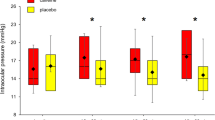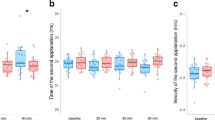Abstract
Background
Caffeine has a well-established effect on intraocular pressure (IOP) and ocular perfusion pressure (OPP); however, the possible differences between low- and high-caffeine consumers remain unknown.
Methods
In this placebo-controlled, double-blind, and balanced crossover study, 40 healthy individuals were divided in low- (n = 21) and high (n = 19)-caffeine consumers, according to their daily caffeine consumption. All participants ingested either caffeine (4 mg/kg) or placebo, and IOP and OPP were measured after 30, 60, and 90 min of ingesting caffeine or placebo. Subjective feelings of arousal were also obtained.
Results
Caffeine induced an acute IOP rise (p < 0.001, ƞp2 = 0.408), whereas habitual caffeine demonstrated a mediating effect on the IOP changes induced by caffeine intake, with high-caffeine consumers showing a less accentuated IOP rise in comparison to low-caffeine consumers. The greatest IOP change induced by caffeine intake was reached after 90 min from capsule ingestion, being more accentuated for the low-caffeine consumers (+ 3.4 mmHg) than for the high-caffeine consumers (+ 1.2 mmHg). Consequently, the participants reported higher levels of perceived arousal after ingesting caffeine in comparison to placebo (p = 0.002, ƞp2 = 0.222); however, similar responses were given by high- and low-caffeine consumers (p = 0.256). Our data did not reveal any effect of caffeine consumption on OPP (p = 0.304).
Conclusions
These results suggest that IOP responsiveness to caffeine ingestion is subject to tolerance, which could have important implication in the management of glaucoma. This finding may be due to alterations in the adenosine receptor system caused by chronic caffeine consumption. Future studies are needed to assess if these findings are also applicable to patients with glaucoma.

Similar content being viewed by others
References
Abokyi S, Owusu-Mensah J, Osei KA (2016) Caffeine intake is associated with pupil dilation and enhanced accommodation. Eye 31:615–619. https://doi.org/10.1038/eye.2016.288
Agnifili L, Mastropasqua R, Frezzotti P, Fasanella V, Motolese I, Pedrotti E, Iorio AD, Mattei PA, Motolese E, Mastropasqua L (2015) Circadian intraocular pressure patterns in healthy subjects , primary open angle and normal tension glaucoma patients with a contact lens sensor. Acta Ophthalmol 93:14–21. https://doi.org/10.1111/aos.12408
Ajayi OB, Ukwade MT (2001) Caffeine and intraocular pressure in a Nigerian population. J Glaucoma 10:25–31. https://doi.org/10.1097/00061198-200102000-00006
Armstrong RA (2013) Statistical guidelines for the analysis of data obtained from one or both eyes. 7–14. https://doi.org/10.1111/opo.12009
Avisar R, Avisar E, Weinberger D (2002) Effect of coffee consumption on intraocular pressure. Ann Pharmacother 36:992–995. https://doi.org/10.1345/aph.1A279
Barone JJ, Roberts HR (1996) Caffeine Consumption. Fd Chem Toxic 34:119–129. https://doi.org/10.1016/0278-6915(95)00093-3
Chan MPY, Grossi CM, Khawaja AP, Yip JL, Khaw KT, Patel PJ, Khaw PT, Morgan JE, Vernon SA, Foster PJ, UK Biobank Eye and Vision Consortium (2016) Associations with intraocular pressure in a large cohort: results from the UK Biobank. Ophthalmology 123:771–782. https://doi.org/10.1016/j.ophtha.2015.11.031
Chandrasekaran S, Rochtchina E, Mitchell P (2005) Effects of caffeine on intraocular pressure: the blue mountains eye study. J Glaucoma 14:504–507
Chen Y, Parrish TB (2009) Caffeine dose effect on activation-induced BOLD and CBF responses. Neuroimage 46:577–583. https://doi.org/10.1016/j.neuroimage.2009.03.012
Cherecheanu AP, Garhofer G, Schmidl D, Werkmeister R, Schmetterer L (2013) Ocular perfusion pressure and ocular blood flow in glaucoma. Curr Opin Pharmacol 13:36–42. https://doi.org/10.1016/j.coph.2012.09.003
Childs E, De Wit H (2006) Subjective, behavioral, and physiological effects of acute caffeine in light, nondependent caffeine users. Psychopharmacology 185:514–523. https://doi.org/10.1007/s00213-006-0341-3
Connell CJW, Thompson B, Turuwhenua J, Hess RF, Gant N (2017) Caffeine increases the velocity of rapid eye movements in unfatigued humans. Psychopharmacology 234:2311–2323. https://doi.org/10.1007/s00213-017-4638-1
Corti R, Binggeli C, Sudano I, Spieker L, Hänseler E, Ruschitzka F, Chaplin WF, Lüscher TF, Noll G (2002) Coffee acutely increases sympathetic nerve activity and blood pressure independently of caffeine content role of habitual versus nonhabitual drinking. Circulation 106:2935–2940. https://doi.org/10.1161/01.CIR.0000046228.97025.3A
Costa VP, Harris A, Anderson D, Stodtmeister R, Cremasco F, Kergoat H, Lovasik J, Stalmans I, Zeitz O, Lanzl I, Gugleta K, Schmetterer L (2014) Ocular perfusion pressure in glaucoma. Acta Ophthalmol 92:252–266. https://doi.org/10.1111/aos.12298
Cuckson AC, Moran P, Seed P, Reinders A, Shennan AH (2004) Clinical evaluation of an automated oscillometric blood pressure wrist device. Blood Press Monit 9:31–37
D’Elia L, la Fata E, Galletti F, Scalfi L, Strazzullo P (2017) Coffee consumption and risk of hypertension: a dose–response meta-analysis of prospective studies. Eur J Nutr 0:1–10. https://doi.org/10.1007/s00394-017-1591-z
De Moraes CGV, Juthani VJ, Liebmann JM et al (2011) Risk factors for visual field progression in treated glaucoma. Arch Ophthalmol 129:562–568. https://doi.org/10.1001/archophthalmol.2011.72
De Moraes CG, Mansouri K, Liebmann JM, Ritch R (2018) Association between 24-hour intraocular pressure monitored with contact lens sensor and visual field progression in older adults with glaucoma. JAMA Ophthalmol 10022:1–7. https://doi.org/10.1001/jamaophthalmol.2018.1746
de Morree HM, Klein C, Marcora SM (2014) Cortical substrates of the effects of caffeine and time-on-task on perception of effort. J Appl Physiol 117:1514–1523. https://doi.org/10.1152/japplphysiol.00898.2013
Dervişoğulları MS, Totan Y, Yüce A, Kulak AE (2016) Acute effects of caffeine on choroidal thickness and ocular pulse amplitude. Cutan Ocul Toxicol 35:281–286. https://doi.org/10.3109/15569527.2015.1104330
Echeverri D, Montes FR, Cabrera M, Galán A, Prieto A (2010) Caffeine’s vascular mechanisms of action. Int J Vasc Med 2010:1–10. https://doi.org/10.1155/2010/834060
Einöther SJL, Giesbrecht T (2013) Caffeine as an attention enhancer: reviewing existing assumptions. Psychopharmacology 225:251–274. https://doi.org/10.1007/s00213-012-2917-4
Ferré S (2008) An update on the mechanisms of the psychostimulant effects of caffeine. J Neurochem 105:1067–1079. https://doi.org/10.1111/j.1471-4159.2007.05196.x
Franklin SS, Khan SA, Wong ND, Larson MG, Levy D (1999) Is pulse pressure useful in predicting risk for coronary heart disease? The Framingham heart study. Circulation 100:354–360. https://doi.org/10.1161/01.cir.100.4.354
Glade MJ (2010) Caffeine-not just a stimulant. Nutrition 26:932–938. https://doi.org/10.1016/j.nut.2010.08.004
Grosso G, Micek A, Godos J, Sciacca S, Pajak A, Martínez-González MA, Giovannucci EL, Galvano F (2016) Coffee consumption and risk of all-cause, cardiovascular, and cancer mortality in smokers and non-smokers: a dose-response meta-analysis. Eur J Epidemiol 31:1191–1205. https://doi.org/10.1007/s10654-016-0202-2
Grosso G, Godos J, Galvano F, Giovannucci EL (2017) Coffee, caffeine, and health outcomes: an umbrella review. Annu Rev Nutr 37:131–156. https://doi.org/10.1146/annurev-nutr-071816-064941
Haskell CF, Kennedy DO, Wesnes KA, Scholey AB (2005) Cognitive and mood improvements of caffeine in habitual consumers and habitual non-consumers of caffeine. Psychopharmacology 179:813–825. https://doi.org/10.1007/s00213-004-2104-3
Hoddes E, Zarcone V, Dement W (1972) Development and use of Stanford Sleepiness Scale (SSS). Psychophysiology 9:150
Ismail A, Bhatti MS, Faye I, Lu CK, Laude A, Tang TB (2018) Pulse waveform analysis on temporal changes in ocular blood flow due to caffeine intake: a comparative study between habitual and non-habitual groups. Graefes Arch Clin Exp Ophthalmol 256:1711–1721. https://doi.org/10.1007/s00417-018-4030-9
Jiwani AZ, Rhee DJ, Brauner SC, Gardiner MF, Chen TC, Shen LQ, Chen SH, Grosskreutz CL, Chang KK, Kloek CE, Greenstein SH, Borboli-Gerogiannis S, Pasquale DL, Chaudhry S, Loomis S, Wiggs JL, Pasquale LR, Turalba AV (2012) Effects of caffeinated coffee consumption on intraocular pressure, ocular perfusion pressure, and ocular pulse amplitude: a randomized controlled trial. Eye 26:1122–1130. https://doi.org/10.1038/eye.2012.113
Kang J, Willet W, Rosner B et al (2008) Caffeine consumption and the risk of primary open - angle glaucoma: a prospective cohort study. Invest Ophthalmol Vis Sci 49:1924–1931. https://doi.org/10.1038/jid.2014.371
Kennedy DO, Haskell CF (2011) Cerebral blood flow and behavioural effects of caffeine in habitual and non-habitual consumers of caffeine: a near infrared spectroscopy study. Biol Psychol 86:298–306. https://doi.org/10.1016/j.biopsycho.2010.12.010
Leske MC (2009) Ocular perfusion pressure and glaucoma: clinical trial and epidemiologic findings. Curr Opin Ophthalmol 20:73–78. https://doi.org/10.1097/ICU.0b013e32831eef82
Li M, Wang M, Guo W, Wang J, Sun X (2011) The effect of caffeine on intraocular pressure: a systematic review and meta-analysis. Graefes Arch Clin Exp Ophthalmol 249:435–442. https://doi.org/10.1007/s00417-010-1455-1
Loftfield E, Cornelis M, Caporaso N et al (2018) Association of coffee drinking with mortality by genetic variation in caffeine metabolism: findings from the UK Biobank. JAMA Intern Med 178:1086–1097. https://doi.org/10.1001/jamainternmed.2018.2425
Mikalsen A, Bertelsen B, Flaten MA (2001) Effects of caffeine, caffeine-associated stimuli, and caffeine-related information on physiological and psychological arousal. Psychopharmacology 157:373–380. https://doi.org/10.1007/s002130100841
Millar-Craig MW, Bishop CN, Raftery EB (1978) Circadian variation of blood-pressure. Lancet 311:795–797. https://doi.org/10.1016/S0140-6736(78)92998-7
Mort JR, Kruse HR (2008) Timing of blood pressure measurement related to caffeine consumption. Ann Pharmacother 42:105–110. https://doi.org/10.1345/aph.1K337
National Health and Medical Research Council (2010) Guidelines for the screening, prognosis, diagnosis, management and prevention of glaucoma. Commonwealth of Australia, Canberra. http://www.nhmrc.gov.au/publications/synopses/cp113syn.htm. Accessed June 2011
Nehlig A, Daval JL, Debry G (1992) Caffeine and the central nervous system: mechanisms of action, biochemical, metabolic and psychostimulant effects. Brain Res Rev 17:139–170. https://doi.org/10.1016/0165-0173(92)90012-B
Nurminen ML, Niittynen L, Korpela R, Vapaatalo H (1999) Coffee, caffeine and blood pressure: a critical review. Eur J Clin Nutr 53:831–839. https://doi.org/10.1038/sj.ejcn.1600899
Okuno T, Sugiyama T, Tominaga M, Kojima S, Ikeda T (2002) Effects of caffeine on microcirculation of the human ocular fundus. Jpn J Ophthalmol 46:170–176. https://doi.org/10.1016/S0021-5155(01)00498-1
Osei KA, Ovenseri-Ogbomo G, Kyei S, Ntodie M (2014) The effect of caffeine on tear secretion. Optom Vis Sci 91:171–177. https://doi.org/10.1097/OPX.0000000000000129
Pakrou N, Gray T, Mills R, Landers J, Craig J (2008) Clinical comparison of the Icare tonometer and Goldmann applanation tonometry. J Glaucoma 17:43–47. https://doi.org/10.1097/IJG.0b013e318133fb32
Quaranta L, Katsanos A, Russo A, Riva I (2013) 24-hour intraocular pressure and ocular perfusion pressure in glaucoma. Surv Ophthalmol 58:26–41. https://doi.org/10.1016/j.survophthal.2012.05.003
Quinlan PT, Lane J, Moore KL, Aspen J, Rycroft JA, O’Brien DC (2000) The acute physiological and mood effects of tea and coffee. Pharmacol Biochem Behav 66:19–28. https://doi.org/10.1016/S0091-3057(00)00192-1
Rysz J, Franczyk B, Banach M, Gluba-Brzozka A (2017) Hypertension - current natural strategies to lower blood pressure. Curr Pharm Des 23:2453–2461. https://doi.org/10.2174/1381612823666170215144649
Schmidl D, Garhofer G, Schmetterer L (2011) The complex interaction between ocular perfusion pressure and ocular blood flow - relevance for glaucoma. Exp Eye Res 93:141–155. https://doi.org/10.1016/j.exer.2010.09.002
Smirmaul BPC, de Moraes AC, Angius L, Marcora SM (2016) Effects of caffeine on neuromuscular fatigue and performance during high-intensity cycling exercise in moderate hypoxia. Eur J Appl Physiol 117:1–12. https://doi.org/10.1007/s00421-016-3496-6
Terai N, Spoerl E, Pillunat LE, Stodtmeister R (2012) The effect of caffeine on retinal vessel diameter in young healthy subjects. Acta Ophthalmol 90:1–5. https://doi.org/10.1111/j.1755-3768.2012.02486.x
Tham YC, Li X, Wong TY, Quigley HA, Aung T, Cheng CY (2014) Global prevalence of glaucoma and projections of glaucoma burden through 2040: a systematic review and meta-analysis. Ophthalmology 121:2081–2090. https://doi.org/10.1016/j.ophtha.2014.05.013
van der Valk R, Webers CA, Schouten JS, Zeegers MP, Hendrikse F, Prins MH (2005) Intraocular pressure–lowering effects of all commonly used glaucoma drugs: a meta-analysis of randomized clinical trials. Ophthalmology 112(7):1177–1185
Vural AD, Kara N, Sayin N, Pirhan D, Ersan HBA (2014) Choroidal thickness changes after a single administration of coffee in healthy subjects. Retina 34:1223–1228. https://doi.org/10.1097/IAE.0000000000000043
Watson J, Deary I, Kerr D (2002) Central and peripheral effects of sustained caffeine use: tolerance is incomplete. Br J Clin Pharmacol 54:400–406. https://doi.org/10.1046/j.1365-2125.2002.01681.x
Acknowledgments
The authors thank to all the participants who selflessly collaborated in this research.
Author information
Authors and Affiliations
Corresponding author
Ethics declarations
The experimental protocol followed the guidelines of the Declaration of Helsinki, and it was approved by the University of Granada Institutional Review Board (IRB approval, 438/CEIH/2017).
Conflict of interest
The authors declare that they have no conflicts of interest.
Rights and permissions
About this article
Cite this article
Vera, J., Redondo, B., Molina, R. et al. Effects of caffeine on intraocular pressure are subject to tolerance: a comparative study between low and high caffeine consumers. Psychopharmacology 236, 811–819 (2019). https://doi.org/10.1007/s00213-018-5114-2
Received:
Accepted:
Published:
Issue Date:
DOI: https://doi.org/10.1007/s00213-018-5114-2




